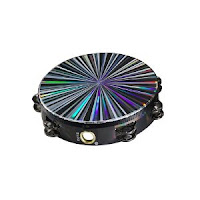With holiday gift giving on everyone’s mind, perhaps a special instrument would complete your holiday shopping. Instruments satisfy a variety of sensory needs. Obviously, as musical instruments, they will all make some sort of auditory sound. However, many of the following instruments also appeal to tactile/vibrotactile, visual, or some other sensory need. In no particular order, here are some of my favorite sensory instruments.
1. Cabasa – Great for vibrotactile needs. It can be used like an OT sensory brush by playing along arms, legs, back, etc. I have also found that many students with autism are fascinated by the beads and being able to spin them around the base.
2. Rainstick – A traditional rainstick is constructed of cactus, which provides a very unique tactile experience. Additonally, the feel of the seeds as they pass through inside tends to be calming for many. Also, there are a variety of children’s rainsticks available, which feature a clear exterior and provide interesting visual stimuli.
3. Ocean Drum – This drum really does sound like the ocean, especially if it is held over your head. The soothing sound of the ocean, combined with the vibrations and the visual appeal of the beads moving inside makes the ocean drum a triple threat.
4. Q-chord – A q-chord is equivalent to an electric autoharp. It is played by pressing a button to create a particular chord and then strumming the finger plate. Some advantages to the q-chord over the autoharp are that they don’t require tuning and also there are song cartridges available, which make playing your favorite songs even easier. I have found that many clients enjoy the vibration of the instrument and it is quite common for them to place their hands over the speaker as a means of receiving even more sensory input. On the other hand, the strings of the autoharp provide a different tactile experience.
6. Gathering Drum – Gathering drums provide a substantial vibrotactile experience. It is usually possible to even feel the drum through the floor!
7 & 8. Buffalo Drum & Paddle Drum – I like these drums because the way in which you hold each drum results in the vibrations actually traveling down your arm towards your core. For some, this is too much stimulation, but others – myself included – love it!
9. Canary Sticks, Quack Sticks, Gobble Sticks, Etc. – I include these as sensory instruments because I have quite a few students with autism who carry “flappers” as a means of providing themselves with stimulation. These instruments provide the same sensation, but also produce sounds and allow my students to successfully participate in the music.
10. Acoustic or Classical Guitar – Between the vibrations of the body, the movement of the strings and the many distinct textures, the guitar fascinates and satisfies many sensory needs with its widespread appeal.
Does my Top Ten match yours? What other sensory instruments would you add to this list?



Chime eggs & song pods are a unique sensation as well. The ocean drum remains my favorite by far though! Recently my students have really gotten into rolling the rhythms sticks on their laps. Even though that verse has no sound production, the heavy pressure seems to work wonders. Kids who don't purposefully participate in other motions, all seem able to do this one.
My kiddos also enjoy rolling rhythm sticks on their laps!
I'm not yet familiar with chime eggs and song pods. Will definitely have to check them out. Thanks for the suggestions!
Cool, Kellee! So happy to find your blog! These are really awesome instrument suggestions that address sensory needs. Awesome. Can't wait to see what other goodies you'll be posting! =)